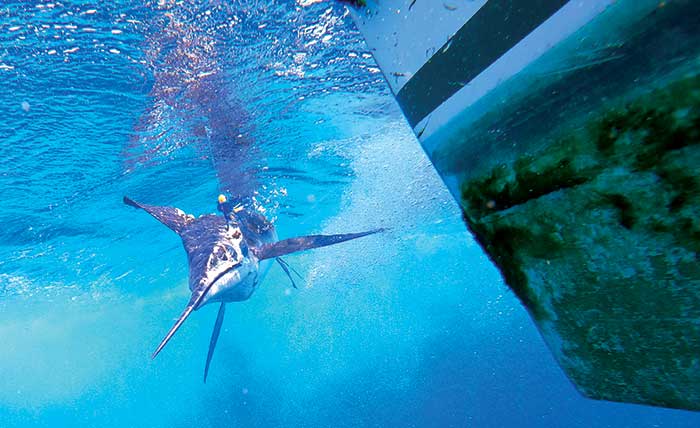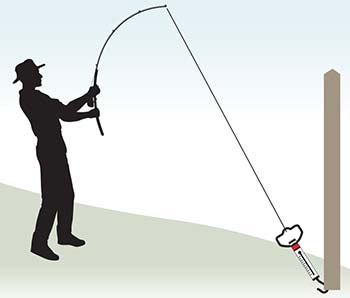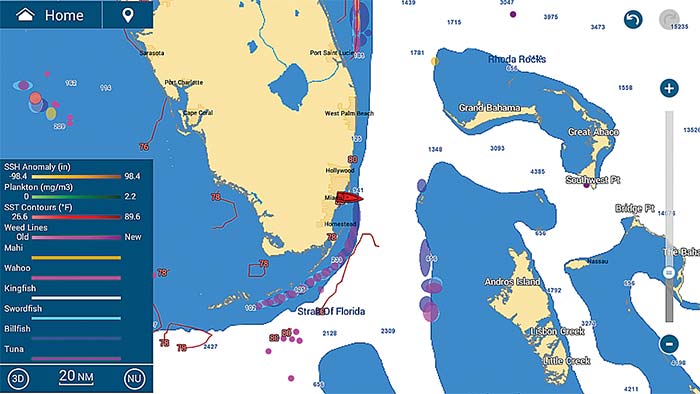Advertisement
You've invested time and effort to improve your offshore fishing game. So why not draw these three aces to better stack the deck in your favor?

How much whitewater and how many vibrations your props kick out will have a direct impact on how many fish you catch. (Photo: Lenny Rudow)
Billfish, tuna, wahoo, and mahi-mahi may be in your targets, but there's nothing easy about hooking, dragging, and landing these denizens of the deep. In fact, just getting out to their turf and giving it a shot involves acquiring piles of gear, rigging for hours on end, filling the fuel tanks, prepping the baits, and gathering intel — lots and lots of intel!
Savvy bluewater anglers will try any trick to make sure their efforts aren't in vain, so if you're planning to head offshore any time soon, tuck these three aces up your sleeve.
1. Tune your props. When the vast majority of boat-owning anglers out there accept delivery of their new or used boat, they also accept the propeller or props that come with it. They neglect to consider the effect those props could have on fish while trolling offshore (not to mention the effect on running efficiency). Propeller inefficiencies produce vibrations. Having your prop(s) tuned can have a huge impact on the vibrations your boat is broadcasting through the water, while also significantly reducing the whitewater in your wake.
A prop tuning involves a computer system that measures in 3D, then compares multiple sections of each blade and determines how they need to be altered to make the blades identical. The blades of a new propeller may look identical to the naked eye, but the pitch between them can differ by up to an inch in some cases. Computer-tuned props can get that difference down to about one-twentieth of an inch. Not only are you likely to catch more fish as a result, but your boat will perform quieter and with more fuel efficiency.
Tools Of The Trade
There are many different types of drags in fishing reels, but they all work on the same basic principle: plates or washers inside the reel create friction against the spool. The tighter you set the drag, the more friction they create.
On most spinning reels, you tighten the drag by turning the drag knob on top of the spool. On conventional gear, you may see either star drags or lever drags. Star drags have a star-shaped wheel you turn to adjust tension. Lever drag reels apply increasing drag force the farther forward you push the drag lever. The range of drag can be fine-tuned by pulling the level to the freespool position and then turning a small wheel or knob.
Regardless of the type of drag your reel has, you can set it with virtually any scale that measures the full range of drag poundage your reel can handle. Most anglers use spring scales (some of which are marketed specifically as drag scales). Choosing one that has a ring marker to indicate the maximum amount of force applied at any given time can be helpful, especially when you don't have a helper who can read the scale as you apply pressure with the rod and reel.
2. Scale-set your drags. Most anglers set their drags by feel, which is a huge mistake when dealing with large pelagics that make screaming runs and push your gear to its limits. Invest in an accurate scale, use it to set those drags, and you'll discover you get fish up to the boat faster and suffer fewer break-offs.

To set a drag properly, you'll need to emulate the real-world line and rod angles you'll experience during battle. (Photo: Lenny Rudow)

When setting your drags, be sure to mimic the real-world rod- and line angles you'll experience during battle. If you pull straight back against a scale held at waist-height, you'll get a very different measurement than if you hold the rod at a 45-degree angle with the scale at water level.
It can be tricky to find the optimal way to emulate real fishing, and you may have to adjust your technique if your boat is on a trailer or in a slip, but make sure the scale is realistically low as compared to where you're standing, and hold the rod exactly as you would during the fight. I do this by attaching the scale to the base of our backyard fence post, then moving back maybe 10 yards and holding the rod in a fighting position. (Be sure to secure the scale to a fixed object as opposed to having a friend hold it, which can introduce inaccuracies as he or she moves when pressure is applied to the line.)
3. Tap into real-time sat tech. For decades, offshore anglers have used satellite technology to help them catch more fish, specifically by viewing sea surface temperatures (SST) charts. A satellite image can be a valuable tool to locate temperature breaks and eddies that attract the pelagic hunters. But in most situations, many hours — sometimes days — will pass between when you look at the latest chart and when you arrive at the fishing grounds. Offshore aficionados looking to gain an edge will do everything they can to make sure they see the latest imagery, even if that means waking up earlier in the predawn hours to check the computer for new satellite shots that may or may not have been updated since the night before.

Fish Mapping includes the oceanographer's color-coded predictions for fish locations.
These days, it's possible to up your game significantly by getting real-time intel from satellites and piping the data directly to the MFD at your helm. Rig your boat for SiriusXM (which generally consists of adding an antenna and/or receiver), activate a monthly subscription, and start applying Fish Mapping intel to your endeavors. That includes the ability to overlay both surface and 30-meter (about 100 feet) subsurface SST charts on your chartplotter (compatible with Garmin, Furuno, Lowrance, Simrad, and Raymarine). As you troll, check out plankton concentration contours, and even use satellite views to spot those elusive weed lines.
Tip
Taking it to the next level, Fish Mapping includes color-coded on-screen recommendations of where to fish when targeting specific species. Oceanographers analyze the satellite data to predict where different types of predators are likely to be, and add a data layer showing the likely presence of each via color-coding.
Will this newfound knowledge propel you onto the leaderboard in the next big tournament? Maybe, maybe not. There are countless variables, tactics, and techniques that come into play every time you set the spread, not to mention the role played by Lady Luck. But these three aces can stack the odds in your favor.

